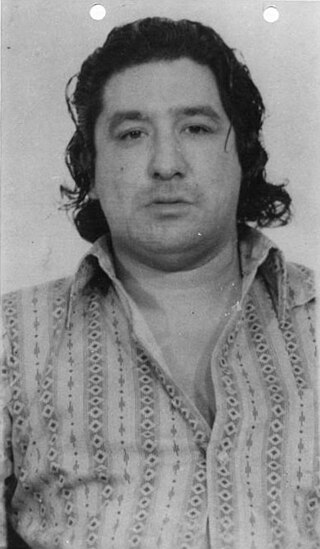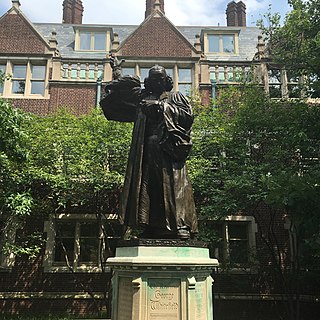
Leonard Peltier is a Native American activist and member of the American Indian Movement (AIM) who was convicted of two counts of first degree murder in the deaths of two Federal Bureau of Investigation (FBI) agents in a June 26, 1975, shooting on the Pine Ridge Indian Reservation in South Dakota. He was sentenced to two consecutive terms of life imprisonment. Peltier became eligible for parole in 1993. On January 19, 2025, Peltier's sentence was commuted to indefinite house arrest by President Joe Biden shortly before he left office. The grant of clemency made the change in detention effective February 18, 2025, and he is scheduled to be transferred on that date.

The American Indian Movement (AIM) is an American Indian grassroots movement which was founded in Minneapolis, Minnesota in July 1968, initially centered in urban areas in order to address systemic issues of poverty, discrimination, and police brutality against American Indians. AIM soon widened its focus from urban issues to many Indigenous Tribal issues that American Indian groups have faced due to settler colonialism in the Americas. These issues have included treaty rights, high rates of unemployment, the lack of American Indian subjects in education, and the preservation of Indigenous cultures.
News From Indian Country was a privately owned newspaper, published once a month in the United States, founded by the journalist Paul DeMain (Ojibwe/Oneida) in 1986, who served as a managing editor and an owner. It was the oldest continuing, nationally distributed publication that was not owned by a tribal government. It offered national, cultural and regional sections, and "the most up-to-date pow-wow directory in the United States and Canada," according to its website. The newspaper was offered both in print and electronic form and has subscribers throughout the United States, Canada and 17 other countries.

A noose is a loop at the end of a rope in which the knot tightens under load and can be loosened without untying the knot. The knot can be used to secure a rope to a post, pole, or animal but only where the end is in a position that the loop can be passed over.

Annie Mae Aquash was a First Nations activist and Mi'kmaq tribal member from Nova Scotia, Canada. Aquash moved to Boston in the 1960s and joined other First Nations and Indigenous Americans focused on education, resistance, and police brutality against urban Indigenous peoples. She was a member of the American Indian Movement (AIM) and participated in several occupations with them. In December 1975, she was kidnapped, raped, and murdered in the Pine Ridge Indian Reservation by members of AIM. Her body was later found in February 1976. In the 2000s, several members of AIM were convicted of kidnapping and murdering her.
Águila Blanca was the name given by Los Macheteros to its robbery of a Wells Fargo depot on September 12, 1983, a day coinciding with the birth date of Puerto Rican Nationalist Dr. Pedro Albizu Campos. The robbery took place in West Hartford, Connecticut, and netted more than US$7 million. At the time of the robbery, it was the largest cash heist in U.S. history.

Incident at Oglala is a 1992 American documentary film directed by Michael Apted and narrated by Robert Redford. The film documents the deaths of two Federal Bureau of Investigation agents, Jack R. Coler and Ronald A. Williams, on the Pine Ridge Indian Reservation on June 26, 1975. Also killed in the multiple fire was Native American Joe Stuntz, a member of the American Indian Movement (AIM), whose death prompted no legal action.

Rigo 23 is a Portuguese-born American muralist, painter, and political artist. He is known in the San Francisco community for having painted a number of large, graphic "sign" murals including: One Tree next to the U.S. Route 101 on-ramp at 10th and Bryant Street, Innercity Home on a large public housing structure, Sky/Ground on a tall abandoned building at 3rd and Mission Street, and Extinct over a Shell gas station. He resides in San Francisco, California.

Robert Eugene Robideau was an American activist who was acquitted in the 1975 shooting deaths of two FBI agents in South Dakota.

Equestrian Statue of Theodore Roosevelt is a 1939 bronze sculpture by James Earle Fraser. It was located on public park land at the American Museum of Natural History in New York City. The equestrian statue depicts Theodore Roosevelt on horseback. Walking on either side of him are two men, on one side a Native American and on the other, a sub-Saharan African.

In the Spirit of Crazy Horse is a book by Peter Matthiessen which chronicles "the story of Leonard Peltier and the FBI's war on the American Indian Movement." It was first published in 1983. Leonard Peltier was convicted of murder in 1977 and sentenced to life in prison for the 1975 killing of two FBI agents, after a trial which the author and many others allege was based on fabricated evidence, widespread fraud and government misconduct.

Nicholas Galanin is a Sitka Tribe of Alaska multi-disciplinary artist and musician of Tlingit and Unangax̂ descent. His work often explores a dialogue of change and identity between Native and non-Native communities.

The bust of Edward Snowden, called Prison Ship Martyrs' Monument 2.0 by its creators, was an ephemeral, illegally installed public sculpture of Edward Snowden, an American whistleblower who leaked classified information from the National Security Agency (NSA) and was charged with federal crimes as a result. The bronze-like bust was placed in Fort Greene Park in Fort Greene, Brooklyn, New York City, on April 6, 2015. This sparked outrage by the Society of Old Brooklynites. It was attached to a Doric column on the perimeter of the park's Prison Ship Martyrs' Monument, a memorial and crypt which honors and inters the more than 11,500 American prisoners of war who died in the American Revolution while housed on British prison ships.
Edgar Donroy Bear Runner was a Native American activist. He is perhaps best known for attempting to peacefully negotiate the Jumping Bull ranch incident in 1975 via parleying with American Indian Movement activists.

The Jefferson Davis Monument, also known as the Jefferson Davis Memorial, was an outdoor sculpture and memorial to Jefferson Davis, installed at Jeff Davis Parkway and Canal Street in New Orleans, Louisiana, United States from 1911 to 2017.
Frank Blackhorse is one of several aliases used by a member of the American Indian Movement. He is perhaps best known for his participation in the Wounded Knee incident, particularly his role in the shootout that left two FBI and one American Indian dead and for becoming a fugitive on the run who fled to Canada shortly after.
Darlene Nichols, also known by the names Kamook, Ka-Mook, Kamook Nichols and Ka-Mook Nichols, is a Native American activist and former member of the American Indian Movement (AIM). She is best known for her role in organizing The Longest Walk, and for serving as a key witness in the trials of AIM members Arlo Looking Cloud, Richard Marshall, and John Graham who were ultimately convicted in the murder of Anna Mae Aquash.
Arlo Looking Cloud is a Native American former activist. He is best known for his involvement in the murder of fellow American Indian Movement activist Anna Mae Aquash. He was convicted of her murder and sentenced to life in prison.
Marina Medvin is an American criminal defense attorney located in Alexandria, Virginia.

The Reverend George Whitefield is a monumental statue which once stood on the campus of the University of Pennsylvania in Philadelphia, Pennsylvania, United States. Dedicated in 1919, it was designed by sculptor R. Tait McKenzie and honors its namesake George Whitefield, Anglican cleric who was a founder of Methodism. In 2020, in reaction to the George Floyd protests, the university administration removed the statue due to Whitefield's defense of slavery.













